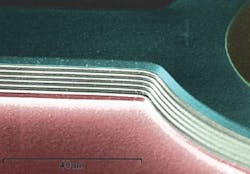Air-gapped distributed Bragg reflector improves dual-band long-wavelength IR cameras
A new sensor configuration developed by Manijeh Razeghi, a researcher at Northwestern University (Evanston, IL), and her colleagues has greatly reduced image degradation caused by the presence of spectral crosstalk between dual-band long-wavelength photodetectors based on antimonide-based type-II superlattices (T2SLs).1 This type of photodetector is especially suitable for use in high-performance infrared cameras.
The work opens the door for a new generation of high spectral-contrast IR imaging devices with applications in medicine, defense and security, planetary sciences, and art preservation.
"Dual-band photodetectors offer many benefits in infrared imaging, including higher quality images and more available data for image-processing algorithms," says Razeghi. "However, performance can be limited by spectral cross-talk interference between the two channels, which leads to poor spectral contrast and prevents infrared camera technology from reaching its true potential."
Dual-band imaging allows for objects to be seen in multiple wavelength channels through a single IR camera. The use of dual-band detection in night-vision cameras, for example, can help the wearer better distinguish between moving targets and objects in the background.
In spectral crosstalk, a portion of the light from one wavelength channel is absorbed by the second channel. The issue becomes more severe as the detection wavelengths get longer. To suppress this, Razeghi and her group in the Center for Quantum Devices developed a novel version of a distributed Bragg reflector (DBR), which is placed between channels to keep the two wavelength bands separate.
While DBRs have been widely used as optical filters to reflect target wavelengths, Razeghi's team is the first to adapt the structure to divide two channels in a T2SL photodetector.
To test their design, the team compared the quantum-efficiency levels of two long-wavelength IR photodetectors with and without the air-gapped DBR. They found notable spectral suppression, with quantum efficiency levels as low as 10%, when using the air-gapped DBR. The results were confirmed using theoretical calculations and numerical simulation.
The research was supported by the Missile Defense Agency, Defense Advanced Research Projects Agency, US Army, and NASA.
Source: https://www.mccormick.northwestern.edu/news/articles/2019/02/new-method-improves-infrared-imaging-performance.html
REFERENCE:
1. Yiyun Zhang et al., IEEE Journal of Quantum Electronics (2018); doi: 10.1109/JQE.2018.2882808.

John Wallace | Senior Technical Editor (1998-2022)
John Wallace was with Laser Focus World for nearly 25 years, retiring in late June 2022. He obtained a bachelor's degree in mechanical engineering and physics at Rutgers University and a master's in optical engineering at the University of Rochester. Before becoming an editor, John worked as an engineer at RCA, Exxon, Eastman Kodak, and GCA Corporation.
